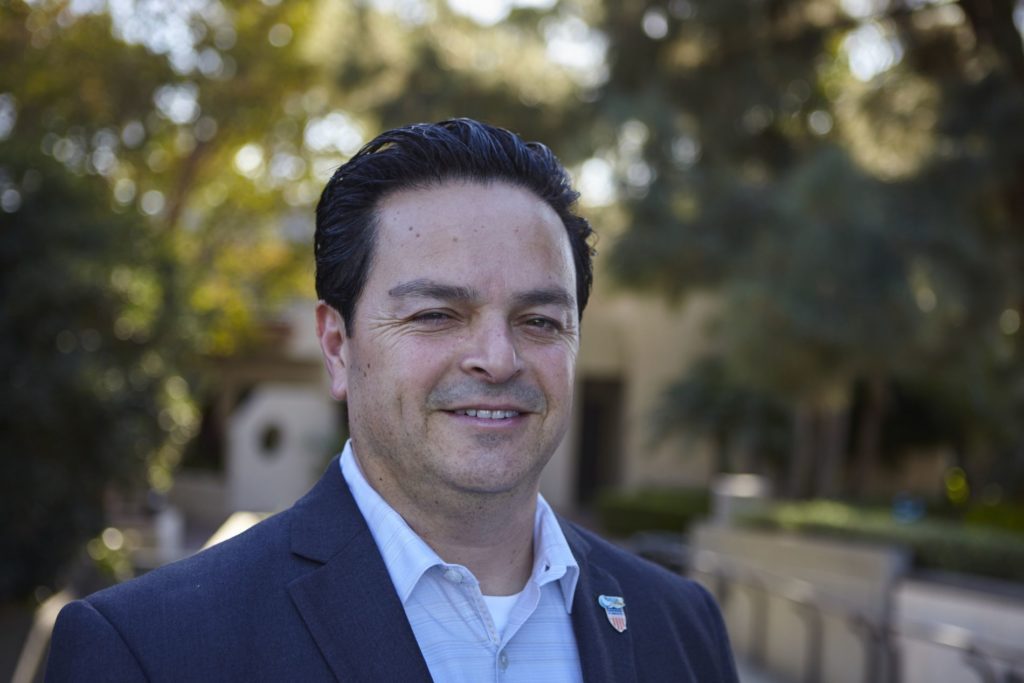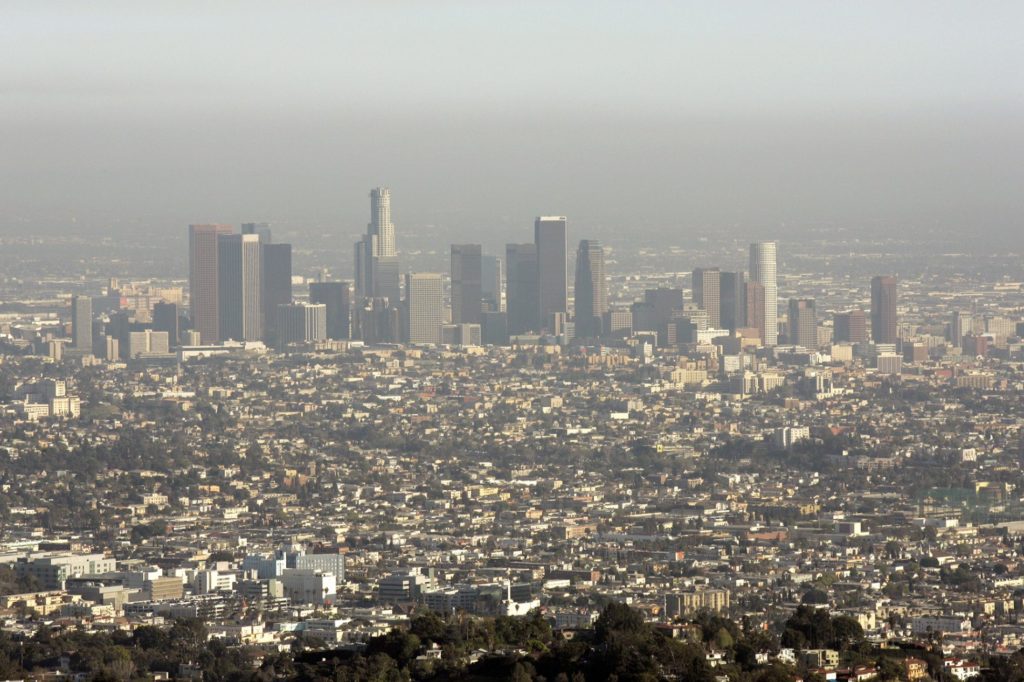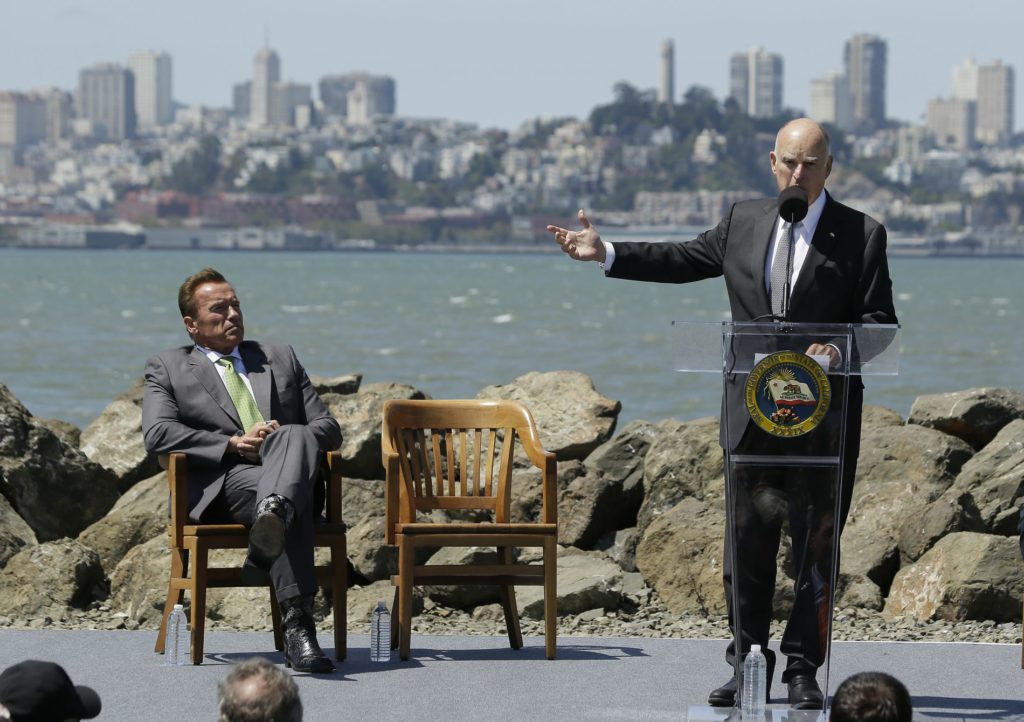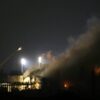Introduction
LOS ANGELES – In their worst moments, the victims’ faces are blue. Their skin is cool and damp to the touch. They are starving for oxygen. Pedora Keo, a critical-care nurse, sees them with distressing regularity: asthmatics in the thrall of attacks that can kill them or decimate their brains. Sometimes they fight while undergoing tracheal intubation and must be restrained. “They’re panicking,” says Keo, 42. “The look on their face is the fear of dying.”
Keo works at St. Mary Medical Center, an Art Deco-style hospital on the west side of Long Beach founded by the Sisters of Charity of the Incarnate Word in 1923. She treats mostly low-income people who live in the brown haze of coastal Southern California’s industrial underbelly. Within six miles of the hospital lie five oil refineries, the sprawling ports of Los Angeles and Long Beach and the truck-clogged 710 and 110 freeways. Los Angeles’ Wilmington neighborhood, a nine-square-mile enclave of Latino immigrants just inland from the ports, gets the worst of it. Its 54,000 residents, many seeking refuge from steep housing prices, breathe some of the foulest air and suffer some of the highest rates of asthma in California. The 92,000 people in neighboring Carson — like Wilmington, working-class and heavily minority – fare no better.
Now, amid the Los Angeles area’s worst smog season in at least 13 years, come new aggravations and anxieties. Andeavor — formerly Tesoro Corp. — plans to merge its Wilmington and Carson refineries into the biggest crude-processing complex on the West Coast. The $460 million project will involve, most notably, the construction of eight hulking storage tanks capable of holding 3.4 million barrels of oil. Meanwhile, state climate legislation endorsed by an unlikely amalgam of businesspeople, environmentalists, lawmakers from both parties and Gov. Jerry Brown has extended a market-based system of pollution-control that some fear will at best maintain the status quo or even make things worse for California’s most vulnerable citizens.
Dolores Linares and her family are among them. Linares, 42, lives in a two-bedroom apartment on East Sandison Street in Wilmington with her partner; her 20-year-old son from a previous union; and two younger sons, both of whom have asthma. Earlier this year the older of the two, 8-year-old Christian Moreno, had an attack so severe it put him in the hospital for a week. Five-year-old Manuel has coughing spells that render him unable to catch his breath or talk. “He starts turning purple, and it’s like he’s going to faint,” his mother says in Spanish. Three refineries clamor and belch within a mile of the apartment. Linares wants to leave as soon as the family can afford it. “We have to move,” she says. “If not, [Christian and Manuel] are always going to be like this.”
Asthma can be triggered by factors such as tobacco smoke, mold and diet. But decades of studies show an unmistakable tie between the respiratory condition and smog. A landmark investigation begun by researchers at the University of Southern California in 1992 found that early-childhood exposure to pollutants can have lifelong consequences, from diminished lung function to chronic absences from school and work. Linda Bassett, a 4th-grade teacher at Gulf Avenue Elementary School in Wilmington, says she paid little mind to the bad air for years but has come to understand its effects on her students. “Every year I’ll have kids come up to me and say, ‘My stomach hurts, my head hurts,’” she says. “I used to think they were trying to ditch class. I don’t dismiss it anymore. I realize they are really hurting.”
The South Coast Air Quality Management District, or AQMD, regulates air pollution in the 10,743-square mile South Coast Air Basin, which includes all of Orange County and urban portions of Los Angeles, Riverside and San Bernardino counties. The basin’s dusky air — blamed for up to 5,000 premature deaths a year in one state estimate — fuels a growing indignation in places like Wilmington and Carson, where oil dominates, as it does in slices of the Bay Area and the San Joaquin Valley. The industry’s influence extends from city halls to Sacramento, forming a narrative that seems counterintuitive in a state known for its forward-thinking climate and public-health policies. Just in the first half of 2017, three of the top four spenders on lobbying in California were oil interests: Chevron, Andeavor and the Western States Petroleum Association, a trade group, which invested a collective $13.5 million. They got much of what they wanted in the climate legislation, signed by Brown in July.

Ted Catanzaro for the Center for Public Integrity
After the city of Carson threatened to sue the AQMD, one of 35 regional pollution-control agencies in California, for approving the Andeavor refinery project this spring, the company offered $45 million over 15 years for landscaping, road repairs and parks. The cash-poor city took the deal and dropped the threat. Mayor Albert Robles says the settlement reflected the city’s lack of faith in officials who blessed the project. The choice, as Robles and the four other members of the city council saw it, was to accept the company’s money or gamble that a judge would convince the AQMD to change its position. The latter seemed unlikely, Robles says. “People talk about environmental justice, how minority communities like Carson are disproportionately affected by pollution,” he says. “This is a clear example. This isn’t 1950 or 1970. This is 2017. To think that in California, the quote-unquote most environmentally progressive state in the country, this regulatory body allowed this to happen is incomprehensible to me.”
The AQMD says that while the Andeavor project will spawn increased emissions of volatile organic compounds — easily evaporable, sometimes cancer-causing chemicals that contribute to smog — “it will not have a significant impact on air quality.”
‘So heavy that it’s unbearable’
In the grand scheme of things, oil refineries account for a small portion of the four-county region’s air pollution. The bigger culprits are cars, trucks, buses, trains and the gargantuan cargo ships that berth at the ports of Los Angeles and Long Beach. In Wilmington and Carson, however, refineries have an outsize effect on people’s health. Last year, AQMD data show, the five refineries in the immediate area — owned by Andeavor, Phillips 66 and Valero — reported releasing nearly 14 million pounds of volatile organic compounds, or VOCs, and so-called criteria pollutants such as nitrogen oxides and fine particles. Studies show the poisons in this brew can cause cancer and heart disease as well as asthma.
The ports recently unveiled a $14 billion plan to switch from diesel trucks and other dirty equipment to zero-emission technologies by 2035. The city of Los Angeles is moving toward an all-electric bus fleet by 2030. The AQMD doesn’t regulate these mobile pollution sources; that duty falls to the state. The district does oversee stationary sources such as refineries, which, an AQMD spokesman says, will be subject in coming years to new prohibitions and penalties for extreme episodes of flaring — the burning of excess gases, which can yield towers of black smoke — and additional requirements to monitor for toxic pollutants along their perimeters.
Relief can’t come soon enough for Dolores Linares, who says the refineries leave a sticky dust on her car and give off an odor “so heavy that it’s unbearable. You even wake up because the smell is so strong — very, very strong, especially in the early morning.” Wilmington Park Elementary School, which Linares’ sons attend along with 800 or so other children, lies less than three-quarters of a mile from Andeavor’s Wilmington refinery, whose tanks and towers are visible from the school’s playground. That operation reported discharging more than 3.3 million pounds of pollutants in 2016, including 95,095 pounds of toxic chemicals such as the carcinogen benzene. The company’s Carson refinery eclipsed those numbers, reporting releases of more than 4.5 million pounds of pollutants, including 374,621 pounds of toxics. In 2015, data from the U.S. Environmental Protection Agency show, seven California refineries — three in the south, four in the north — were among the top 10 industrial sources statewide for both greenhouse-gas and toxic air emissions.
It gets worse. A study commissioned by the AQMD in 2015 and published this year found that VOC emissions from the Wilmington and Carson refineries — and two others in nearby Torrance and El Segundo — over a 2 ½-month period were 2.7 to almost 12 times higher than what had been assumed. Benzene emissions were undercounted by factors ranging from 3.2 to 202. Researchers with a Swedish firm called FluxSense Inc. used optical remote sensing devices to calculate levels of chemicals wafting invisibly from storage tanks, pipes and other equipment and compared that data to estimates made by the refinery operators. FluxSense’s Johan Mellqvist says all refineries lose gases and vapors “from many points. Many small leaks make a big leak.”
For this reason and others, the AQMD’s green-lighting of the Andeavor project in May did not sit well with public-health advocates. Two groups sued the agency, claiming, among other things, that its review of the company’s environmental impact report glossed over the FluxSense findings. Phyllis Fox, an expert hired by one of the groups, Safe Fuel and Energy Resources California, calculated that VOC emissions from the new crude storage tanks and other equipment within the 930-acre complex could be almost 30 times what the report predicts. AQMD officials wouldn’t respond to the allegation, citing the nascent litigation. In comments attached to the report, however, the district said it must rely on estimates “because real-time monitoring cannot be performed on equipment that has not been built.”
Andeavor says there’s no reason to believe that the anticipated bump in refining capacity — 6,000 barrels of oil per day on top of the 380,000 barrels already coursing through the Wilmington and Carson sites — will translate into dirtier air. In fact, it claims the replacement of old equipment will lead to a reduction in greenhouse-gas emissions — “the equivalent of removing more than 13,500 passenger vehicles from local roads each year” — and pollution from sulfur and nitrogen oxides, fine particles and carbon monoxide. But Julia May, a senior scientist with Communities for a Better Environment, the other group that’s suing over the project, says Andeavor’s own statements to investors suggest it expects to bring in greater amounts of highly volatile crude from North Dakota’s Bakken shale formation and asphalt-like tar sands from Alberta, raising the prospect of explosions during transport and more air pollution. The environmental impact report fails to account for this likely shift, the lawsuit alleges. The company insists the mix of crudes it refines won’t change.
The AQMD says it received more than 2,100 written or verbal comments on the refinery merger, more than three-quarters of which were supportive. Many of those who objected did so passionately. Maria Brizeño of Wilmington wrote, “We are already surrounded in all directions by refineries. I see them from all my windows. I cannot open my windows at night because the oil smell is too strong and noxious. In the morning, my yard is covered with soot. We do not need more hazards.” Sylvia Arredondo, also of Wilmington, collected comments from fellow residents, including Armando G. Soto, who wrote, “The only thing I’ve ever received from the refineries is the f***ing asthma I suffer from today.” In April, the annual People’s Climate March Los Angeles was held in Wilmington for the first time, and about 5,000 people turned out. Much of their ire was directed at the company then known as Tesoro.
U.S. Rep. Nanette Diaz Barragán, a Democrat whose district includes Wilmington and Carson, urged the U.S. EPA in a June 1 letter not to grant Andeavor the permit revisions it needed to go forward with the project, saying its impacts “are not theoretical or abstract but would [have] real-life consequences that my constituents, many of whom are low-income or of color, would live with every day of their lives.” The EPA responded that it had approved the revisions after consulting with the AQMD and conducting its own review to confirm that Andeavor would use the best pollution controls and that the company’s emissions estimates were accurate. Philip Fine, a deputy executive officer with the AQMD, says refineries in the L.A. area are rigorously policed. “We probably have the most stringent rules and regulations in the nation when it comes to refineries,” he says. Pollution violations alleged by the district led to a collective $145 million in settlements with refiners from 2002 through July of this year, records show; $81 million of that came in a single settlement with BP in 2005, when it owned the Carson refinery now operated by Andeavor.
But Barragán, a lawyer raised in an immigrant family, suspects her district’s demographics make it easier for regulators to dismiss residents’ concerns. “My mother would always say, ‘We’re just happy to be here. We don’t ask questions. We don’t challenge people.’” Fear of deportation or other forms of retribution looms large in a place where much of the conversation and signage are in Spanish. “Having the largest [West Coast] refinery in my district, one of the most heavily polluted in the country, is not something I’m proud of,” the freshman congresswoman says. “This would not be happening in Hermosa Beach or Beverly Hills or Malibu.”
Her counterpart in the state Assembly, Mike Gipson, has been a top recipient of oil-industry largesse. Lobbying reports show that from the time he was elected in 2014 through 2016, Gipson accepted meals and lodging valued at $4,585 — the highest dollar amount in the California legislature for that period — from the Western States Petroleum Association (WSPA), which represents oil and gas producers and refiners, and the California Independent Petroleum Association (CIPA), which represents only producers. Among the perks was a nearly $1,500 stay at the Ritz Carlton in Half Moon Bay, south of San Francisco, for a WSPA conference. He also took in at least $71,950 in oil-industry contributions during his 2014 and 2016 campaigns — fourth-most among state lawmakers. And in 2015, WSPA made a $10,000 charitable donation at Gipson’s request to a wilderness camp for underprivileged boys. All of this was legal.
Gipson, a Democrat whose district runs from Wilmington in the south to Watts in the north, has taken positions aligned with his benefactors — opposing, for example, a provision in a 2015 clean-energy bill that would have committed the state to a 50-percent reduction in oil use within 15 years. The provision was stripped from the bill before it passed. A spokesman said Gipson would have no comment for this article. WSPA said in a statement that its “lobbying activities are a direct reflection of the enormous number of issues confronting the energy industry in California, and the potential impact those issues have on energy producers, refiners, consumers and businesses.” CIPA said its spending “reflects the complexity of the issues facing oil producers and the need to educate lawmakers about the impacts state policy will have on jobs, the economy, and the price of energy in California.”

Richard Vogel/AP
Battle over cap-and-trade
While the air in the South Coast basin is cleaner than it was decades ago, the basin is still classified by the U.S. EPA as one of only two “extreme non-attainment” areas in the nation for ozone, the main ingredient in smog. (The San Joaquin Valley is the other.) Regulators have struggled to find ways to cut industrial emissions without crippling the region’s economy, and nearly 30 years ago took a stab at what’s known as cap-and-trade. Facing new federal mandates, the AQMD began discussions in September 1990 with Robert Wyman, a lawyer in the Los Angeles office of Latham & Watkins who represented oil companies, power generators and other business interests. Wyman, himself an asthmatic who spent part of his youth in Pasadena, had helped shape amendments to the Clean Air Act that would be signed into law later that fall by President George H.W. Bush. The amendments ratcheted up pressure on industry to slash emissions even though “the [pollution-control] technologies weren’t obvious,” Wyman says. Rather than stick with prescriptive, “command-and-control” enforcement — ordering businesses to adopt measures that in extreme cases would expunge pollution at the staggering cost of $100,000 per ton — the AQMD should move to a market-based system that set a price on emissions and gave companies flexibility to develop their own solutions, Wyman argued. The law explicitly encouraged such creativity.
The Regional Clean Air Incentives Market, or RECLAIM, was born on January 1, 1994. The idea was straightforward: Emission limits were established for big sources of smog-forming nitrogen oxides and lung-searing sulfur oxides; each participating facility received an annual allotment of credits equal to its limit. Excess credits could be sold to companies that couldn’t or chose not to stay under the emission cap. Over time, the number of credits would decrease, the price would rise and pollution would diminish.
From 1994 through 2015, levels of both nitrogen oxides and sulfur oxides in the basin fell by 71 percent, AQMD data show. “I would classify [RECLAIM] as a resounding success,” says Laki Tisopulos, a deputy executive officer with the district. But the program didn’t achieve the pollution reductions envisioned when it was launched; credits stayed cheap and “artificially depressed” prices, the U.S. EPA found. Companies had little motivation to install costly emission controls. The AQMD’s own staff reported in November 2015 that emissions of nitrogen oxides — mostly from refineries — still totaled 20.7 tons per day in 2011. Had the old, command-and-control framework remained in place, the staff calculated, emissions would have been less than half that amount: 9.5 tons per day.
The AQMD staff, backed by then-Executive Officer Barry Wallerstein, recommended that the supply of credits for nitrogen oxides be curtailed to squeeze fat out of the program. WSPA had anticipated a more modest trim and objected. At a hearing in December 2015, the AQMD’s governing board, then with a Republican majority, voted to reject the staff proposal and side with WSPA. Three months later, Wallerstein — who could not be reached for comment for this article — was fired with no public explanation. In March of this year, the board — having shifted back to a Democratic majority — voted to phase out RECLAIM on a timetable yet to be determined. “The fact of the matter is, the program just wasn’t as tight as it should have been,” says Adrian Martinez, a staff attorney in Los Angeles with the nonprofit law firm Earthjustice who welcomes RECLAIM’s demise. Martinez offers grudging kudos to the oil companies for milking the program, saying, “Refineries are masters at using credit systems to their benefit – better than any other polluting industry out there. They are the LeBron James of using credit systems.”
For this reason, some environmental advocates grew leery this spring when Brown began prodding the California Legislature to extend the state’s four-year-old cap-and-trade program. The program places a gradually tightening limit on greenhouse gases while allowing polluters to either cut emissions or buy credits, known as allowances. The results have been mixed. Greenhouse-gas emissions statewide are edging down despite a growing economy, and Brown has won international praise for taking on climate change. Because of an oversupply of allowances and lenient policies exploited by polluters, however, low-income, mostly minority communities like Wilmington — where dirty industries tend to cluster — have yet to see significantly cleaner air. Oil refining shows an especially strong correlation between greenhouse-gas and toxic-air emissions, a study this year by the California Environmental Protection Agency found. Under cap-and-trade, greenhouse-gas emissions for the industry have barely budged.
California’s cap-and-trade program is the outgrowth of 2006 legislation that set ambitious goals for greenhouse-gas cuts. Emissions are to drop to 1990 levels by 2020 and another 40 percent by 2030. By most legal interpretations, the program needed a two-thirds vote by the Legislature to keep going beyond 2020. Brown, whose term ends in 2019, took it upon himself to broker a deal and sought early buy-in from WSPA and other oil interests. Those interests helped derail legislation introduced in June by Assemblywoman Cristina Garcia, a Democrat whose industry- and traffic-heavy district lies southeast of downtown Los Angeles. Garcia’s bill would have made continued participation in the cap-and-trade program contingent upon the reduction of toxic air pollutants, not merely greenhouse gases. It failed in the Assembly by three votes, with Assemblyman Gipson abstaining. “The biggest pushback, in all honesty, came from the oil industry,” Garcia says. (Brown’s relationship with the industry is complicated. Despite his reputation as a climate-change evangelist, he drew criticism for firing two state regulators whose aggressive approach to enforcement had provoked powerful oil companies. The industry came through when he needed business support for a 2012 measure raising taxes on the wealthy to bolster education. Oil’s imprint on California is undeniable: It contributes “more than $148 billion in direct economic activity” and “support[s] 368,100 total jobs,” according to a recent study commissioned by WSPA.)
Two new pieces of legislation — Assembly Bill 398, addressing cap-and-trade, and AB 617, addressing air quality — took shape after Garcia’s bill went down. AB 398 extended cap-and-trade through 2030 and restricted, but didn’t ban, polluters’ use of offset allowances, which enable the owner of a refinery in Los Angeles to meet some of its climate obligations by planting trees in Arkansas. It took away local air-quality districts’ power to regulate greenhouse-gas emissions from refineries — something the Bay Area Air Quality Management District was pondering as recently as June. AB 617 was an attempt to get skeptical environmental-justice advocates on board with the cap-and-trade legislation. It increased penalties for air-pollution violations and called for advanced air-quality monitoring in “fence-line” communities such as Wilmington. It decreed that industrial facilities in smoggy areas install state-of-the-art controls no later than Dec. 31, 2023.

Eric Risberg/AP
The bills passed on July 17 — AB 398 by the narrowest of margins, AB 617 more comfortably since it needed only a simple majority (Gipson voted yes on both). Accolades came quickly. The editorial board of The New York Times congratulated California for making a “bold, bipartisan commitment that invites similarly ambitious policies from other states [and] sends a strong signal to the world that millions of Americans regard with utmost seriousness a threat the Trump administration refuses to acknowledge, let alone reckon with.” Brown declined through a spokesman to be interviewed for this article, though the spokesman noted in an email that an “unprecedented coalition of more than 150 environmental, business, health, labor, agricultural and community organizations all came together to shape this legislation.” On July 25 – the day he signed AB 398 into law on Treasure Island, with San Francisco’s skyline in the background — the governor praised lawmakers for acting on “the existential threat that humanity faces.” He thanked former Gov. Arnold Schwarzenegger, seated to his right, for Schwarzenegger’s support of the original, 2006 climate legislation. He cautioned that de-carbonization would not happen right away – “We can’t just say, overnight, ‘We’re not going to use oil anymore’” — but said California’s initiative was “pretty great” and destined to be copied by other states and nations.
WSPA later said in a statement that AB 398 would help “the [oil] industry compete in the world’s most stringent regulatory environment.” Indeed, the industry dodged a bullet: In January, six months before the bill became law, the staff of the California Air Resources Board, a regulatory agency, proposed that California refineries be forced to cut greenhouse-gas emissions 20 percent by 2030, saying such a move “may provide co-benefits of reducing criteria pollutants and toxic air contaminants in some of the most polluted and disadvantaged communities in the State.” The proposal could have led to a rule. “What we know now is, that won’t happen,” says board member Diane Takvorian.
The Natural Resources Defense Council was among the mainstream environmental groups that endorsed AB 398. “There was no path to getting a two-thirds vote that didn’t involve compromise,” says Alex Jackson, legal director of the NRDC’s California Climate Program. “Were there concessions to industry? Absolutely. But they didn’t cross a line.” Assemblyman Eduardo Garcia, a Democrat from Southern California’s Coachella Valley who is not related to Cristina Garcia, was the bill’s lead sponsor. Garcia says the successful auction of allowances by the Air Resources Board in August shows that businesses welcome the certainty afforded by the legislation. The auction raised $642 million for California’s Greenhouse Gas Reduction Fund; if historical patterns hold, half of that money will go to projects in poor communities. “Extending the [cap-and-trade] program sent strong signals to the market and the market responded,” Garcia says. “These are very capitalist, Republican types of principles.”
‘Born in original sin’
Not everyone shares Garcia’s enthusiasm. RL Miller, who chairs the California Democratic Party’s Environmental Caucus, helped lead the charge against AB 398 by environmental-justice groups. “It was born in original sin,” she says. “It literally came from WSPA’s wish list.” Kathryn Phillips, director of Sierra Club California, which also opposed the legislation, says it was a product of Brown’s “kowtowing to the oil industry.” Phillips says that some of the bill’s worst provisions were excised, but at least one survived: The prohibition against local air districts regulating carbon dioxide. Her worry is that clever industry lawyers might argue the districts also can’t regulate co-pollutants like nitrogen oxides or benzene.
AB 398 left it to the Air Resources Board to fix a core flaw in the cap-and-trade program: the glut of allowances, which, the nonpartisan Legislative Analyst’s Office said, “potentially increases emissions and puts downward pressure on prices.” Some of these allowances are, and will continue to be, handed out for free. Danny Cullenward, an energy economist and a lawyer who advised legislators during last summer’s debate in Sacramento, says the giveaways are justified in certain cases; businesses that operate on thin margins could be forced to shut down or flee California without help. But 72 percent of the free industrial allowances last year went to the oil and gas sector, which includes production and refining. AB 398 locked in these subsidies – worth “many billions of dollars,” Cullenward says – through 2030. Air Resources Board Member Dean Florez says the agency “needs to be much more discerning” about the handouts and ask itself, “Are very large companies really going to leave? When we talk about the oil companies – come on, they aren’t going anywhere.
Board spokesman Stanley Young acknowledges that refineries are unlikely to move but says “they could reduce production and import more fuel from out of state.” Young says there are mechanisms in place to deal with the oversupply of allowances and warns critics against missing the bigger picture: California is doing something tangible and consequential about climate change. The extension of cap-and-trade means that greenhouse-gas emissions statewide will have to come down “four percent a year, every year, from 2020 to 2030,” he says. “One way or another, all of the industries in California are going to have to meet these ambitious greenhouse-gas limits.”
But the cap-and-trade program could have been made even stronger. A bill introduced just prior to AB 398 by state Sen. Bob Wieckowski, a Democrat from the East Bay, would have done away with offsets and free allowances and set slowly rising floors and ceilings on the price of carbon to make it more expensive to pollute. The idea, Wieckowski said in June, was to make companies “pay real money” for their emissions. His bill was held in committee and became moot when AB 398 passed – though it could, in theory, be revived at some point.
The nurse, the mom and the mayor
Pedora Keo, the nurse in Long Beach, wasn’t happy when she learned how the climate negotiations in Sacramento had played out. “I think it’s a giveaway to the oil companies,” she says. For Keo the fight is intensely personal. Her 15-year-old son, Vincent Rol, was diagnosed with asthma when he was a year old and had to be hospitalized for several days when he was 5. “Shallow, rapid breathing,” his mother says, recalling the boy’s symptoms. “I could hear the wheezing sound.” Vincent’s asthma is mostly under control, Keo says, but he remains at risk. “One day he could have an attack, and it could be the end of his life.”
Dolores Linares says her two asthmatic sons “don’t have a good quality of life right now — like normal boys” in Wilmington. When the older one, Christian, had his attack earlier this year, “He had been coughing for, like, two days. And one day, around midnight, he was wheezing and his stomach hurt when he was breathing. He was really agitated, so I took him to the emergency room and they told me he had to stay. They put him on oxygen to stabilize him, and a lot of medicine.” The boys’ doctors, she says, “have told me it’s too contaminated and we need to leave.” For now, she and her partner, a chauffeur, are stuck. The money isn’t there.
In Carson, Mayor Robles is trying to be pragmatic. The city, which declared a fiscal emergency in August, will try to improve its quality of life with the $45 million from Andeavor. And, at Robles’ urging, it will go a step further. On the November ballot will be a measure to boost taxes on all petroleum operations in the city — refineries owned by Andeavor and Phillips 66 as well as facilities owned by Shell Oil and Kinder Morgan. Research by city staff shows that Carson brought in about $5 million from these operations last year. Torrance and El Segundo, each with a single refinery, saw double that amount. The Bay Area city of Richmond, also with one refinery, collected nearly $33 million. “The time has come,” Robles says, “for Carson to be treated fairly.”
Michael J. Mishak, Maryam Jameel and Joe Yerardi contributed to this story.
Read more in Environment
Carbon Wars
A behind-the-scenes look at Scott Pruitt’s dysfunctional EPA
Career employees at the agency say political appointees are shutting them out of decision-making. They worry that the public will suffer.
Carbon Wars
Big power plant ignites political fight in small Pennsylvania town
A wave of new gas-fired power plants is hitting the nation, with uncertain implications for the climate. The local consequences can be just as thorny.






Join the conversation
Show Comments